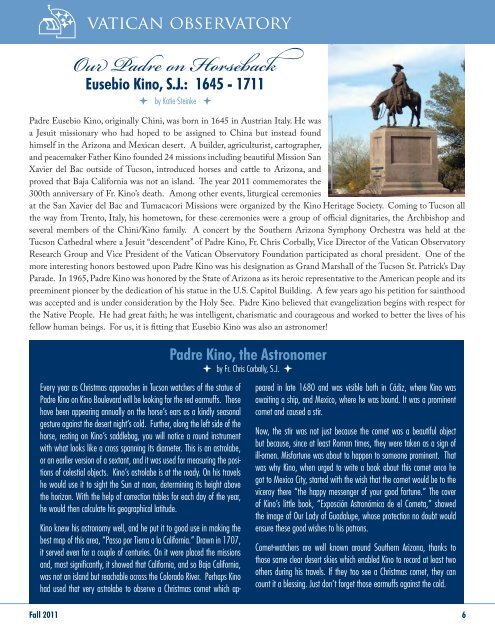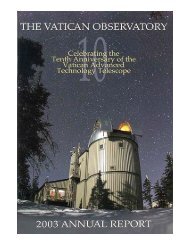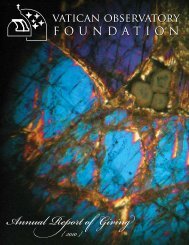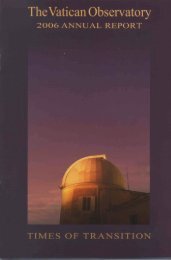Newsletter Fall 2011 - Vatican Observatory
Newsletter Fall 2011 - Vatican Observatory
Newsletter Fall 2011 - Vatican Observatory
You also want an ePaper? Increase the reach of your titles
YUMPU automatically turns print PDFs into web optimized ePapers that Google loves.
vatican observatory<br />
Our Padre on Horseback<br />
Eusebio Kino, S.J.: 1645 - 1711<br />
by Katie Steinke<br />
Padre Eusebio Kino, originally Chini, was born in 1645 in Austrian Italy. He was<br />
a Jesuit missionary who had hoped to be assigned to China but instead found<br />
himself in the Arizona and Mexican desert. A builder, agriculturist, cartographer,<br />
and peacemaker Father Kino founded 24 missions including beautiful Mission San<br />
Xavier del Bac outside of Tucson, introduced horses and cattle to Arizona, and<br />
proved that Baja California was not an island. The year <strong>2011</strong> commemorates the<br />
300th anniversary of Fr. Kino’s death. Among other events, liturgical ceremonies<br />
at the San Xavier del Bac and Tumacacori Missions were organized by the Kino Heritage Society. Coming to Tucson all<br />
the way from Trento, Italy, his hometown, for these ceremonies were a group of official dignitaries, the Archbishop and<br />
several members of the Chini/Kino family. A concert by the Southern Arizona Symphony Orchestra was held at the<br />
Tucson Cathedral where a Jesuit “descendent” of Padre Kino, Fr. Chris Corbally, Vice Director of the <strong>Vatican</strong> <strong>Observatory</strong><br />
Research Group and Vice President of the <strong>Vatican</strong> <strong>Observatory</strong> Foundation participated as choral president. One of the<br />
more interesting honors bestowed upon Padre Kino was his designation as Grand Marshall of the Tucson St. Patrick’s Day<br />
Parade. In 1965, Padre Kino was honored by the State of Arizona as its heroic representative to the American people and its<br />
preeminent pioneer by the dedication of his statue in the U.S. Capitol Building. A few years ago his petition for sainthood<br />
was accepted and is under consideration by the Holy See. Padre Kino believed that evangelization begins with respect for<br />
the Native People. He had great faith; he was intelligent, charismatic and courageous and worked to better the lives of his<br />
fellow human beings. For us, it is fitting that Eusebio Kino was also an astronomer!<br />
Padre Kino, the Astronomer<br />
by Fr. Chris Corbally, S.J.<br />
Every year as Christmas approaches in Tucson watchers of the statue of<br />
Padre Kino on Kino Boulevard will be looking for the red earmuffs. These<br />
have been appearing annually on the horse’s ears as a kindly seasonal<br />
gesture against the desert night’s cold. Further, along the left side of the<br />
horse, resting on Kino’s saddlebag, you will notice a round instrument<br />
with what looks like a cross spanning its diameter. This is an astrolabe,<br />
or an earlier version of a sextant, and it was used for measuring the positions<br />
of celestial objects. Kino’s astrolabe is at the ready. On his travels<br />
he would use it to sight the Sun at noon, determining its height above<br />
the horizon. With the help of correction tables for each day of the year,<br />
he would then calculate his geographical latitude.<br />
Kino knew his astronomy well, and he put it to good use in making the<br />
best map of this area, “Passo por Tierra a la California.” Drawn in 1707,<br />
it served even for a couple of centuries. On it were placed the missions<br />
and, most significantly, it showed that California, and so Baja California,<br />
was not an island but reachable across the Colorado River. Perhaps Kino<br />
had used that very astrolabe to observe a Christmas comet which appeared<br />
in late 1680 and was visible both in Cádiz, where Kino was<br />
awaiting a ship, and Mexico, where he was bound. It was a prominent<br />
comet and caused a stir.<br />
Now, the stir was not just because the comet was a beautiful object<br />
but because, since at least Roman times, they were taken as a sign of<br />
ill-omen. Misfortune was about to happen to someone prominent. That<br />
was why Kino, when urged to write a book about this comet once he<br />
got to Mexico City, started with the wish that the comet would be to the<br />
viceroy there “the happy messenger of your good fortune.” The cover<br />
of Kino’s little book, “Exposción Astronómica de el Cometa,” showed<br />
the image of Our Lady of Guadalupe, whose protection no doubt would<br />
ensure these good wishes to his patrons.<br />
Comet-watchers are well known around Southern Arizona, thanks to<br />
those same clear desert skies which enabled Kino to record at least two<br />
others during his travels. If they too see a Christmas comet, they can<br />
count it a blessing. Just don’t forget those earmuffs against the cold.<br />
<strong>Fall</strong> <strong>2011</strong> 6







